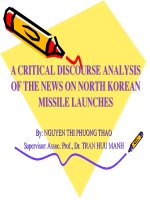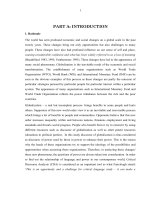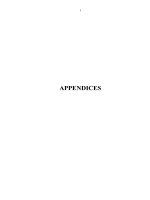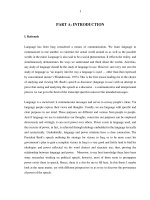Critical analysis
Bạn đang xem bản rút gọn của tài liệu. Xem và tải ngay bản đầy đủ của tài liệu tại đây (569.17 KB, 13 trang )
What is a literary analysis?
A literary analysis is an
interpretation of the written text,
which involves the use of concepts
specifically associated with
literature.
Literary Concepts
The Basics
Additional Concepts
Plot
Historical Content
Setting
Social significance
Characterization
Political view point
Symbolism
Ideology
Metaphors
Critical Orientation
Genre
Literary Theory
Irony/ambiguity
Multiple voices
Narration/ambiguity
How to argue in an analysis
Focus on specific attributes of the text:
Make sure your specific point(s) (thesis) are arguable.
Defend your point(s) with reason, based on evidence
from the text (dialogue, description, setting, etc.).
Argue your points much like a legal advocate. You can
argue either strongest evidence first/weakest last or
vice versa, whatever works best in your opinion.
Remember, your audience is the judge.
Thesis Statements
The thesis statement:
Sets the argument to control the focus of the entire
paper
Provides unity and a sense of direction
Specifies to the reader (audience) the point of the
analysis
Thesis Statements
In Death of a Salesman Miller uses Uncle Charlie’s
relationship with his successful son Bernard to
emphasize Willy Loman’s failure as a father.
The Great Gatsby presents a world in which marriage,
the stock market, and even the World Series are
corrupted by selfish greed.
Ralph Ellison’s “Battle Royale” highlights the
bankruptcy of Booker T. Washington’s “separate but
equal” approach to race relations.
How to Support a Thesis Statement
Use examples from the text:
Direct quotations
Summaries of scenes
Paraphrases
Other critic’s opinions
Historical, social, economic context
Use secondary sources
Secondary Sources
What is a secondary source?
A book or article that discusses the text you are
discussing.
A book or article that discusses a theory related to the
argument you are making.
A book or article that discusses the social, political, or
economic context of the text you are discussing.
Integrating Secondary Sources
Be sure to show how a secondary source relates to your
thesis.
Don’t overuse any one secondary source, or for that
matter, secondary sources in general.
Remember that this is your paper, your argument –
the secondary sources are just helping your argument.
NEVER plagiarize from a secondary source.
Additional Strategies
1.
2.
3.
4.
5.
6.
7.
8.
Avoid summarizing the work analyzed.
Narrow the scope of your response.
Pre-write to explore the topic & develop a thesis.
Support your thesis with evidence from the text.
Avoid extensive direct quotations.
Write in the present tense.
After writing the first draft, review the work and
examine your thesis and supporting evidence.
Proofread & re-write – Do NOT rely on spellcheck!
Where Can I Go for More Help
The Rio Grande Campus Writing Center
Bldg. A Room 112
Monday – Thursday
8am – 5p
Friday
8am – 3pm
The Moon Cannot Be Stolen
Ryokan, a Zen master, lived the simplest kind of life in a little hut at the
foot of a mountain. One evening a thief visited the hut only to
discover there was nothing in it to steal.
Ryokan returned and caught him. "You may have come a long way to
visit me," he told the prowler, "and you should not return empty
handed. Please take my clothes as a gift."
The thief was bewildered. He took the clothes and slunk away.
Ryokan sat naked, watching the moon. "Poor fellow, " he mused, "I wish
I could give him this beautiful moon."








